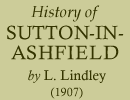< Previous | Contents | Next >
HIGHER STANDARD TEMPORARY SCHOOL.
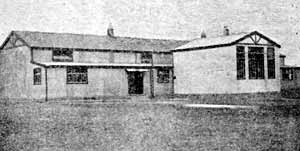 |
In 1905, the Notts. Education Committee purchased the site for this School, which is situated in Forest Street, opposite the Midland Railway Station, at a cost of £2,130, the area being about 6100 yds., and on March 5th, 1906, the temporary building (as shown above), was opened by Councillor G. Stevenson, the then Chairman of the Sutton School Managers. It is a mixed school, with upwards of 250 names on the books. Standards VI. and VII, and students more advanced still, receive their instruction here, 54 children studying in a higher standard than the VII. A new room was added and opened early in October, 1906. which is fitted up in the same way as a Secondary School, i.e., each child has a single desk to itself. This room accommodates 25 students, and there is a greater allowance of air space than in the other rooms. The subjects taken, in addition to the ordinary ones, are—Shorthand, French, Science, and Mathematics. The whole school is under the superintendence of Mr. W. Collins, B.A., Int. B.Sc. A scheme for the erection of a permanent school has been-approved by the Education Committee, and a start will be made on the new building at an early date. Accommodation will be provided for 850 scholars, the cost being estimated at £7,030.
BANKS.
The Union of London and Smith's Bank. Ltd., Market Place; established 1873; manager, Mr. B. F. Hubble.
The Nottingham and Notts. Bank, Low Street (formerly known as Albert Square); established 1873; manager. Mr. C. Swire.
The Crompton and Evans' Union Bank. Limited, Low Street; established Feb. 1st, 1894; manager. Mr. H. J. Bosworth.
ANGLING SOCIETY.
This Society was formed in 1900, and has a membership of 28. The headquarters is the Apollo Tavern, Eastfield Side, and angling waters the Mill Dam. Secretary, Mr. F. Hallam, Brook Street, Sntton-in-Ashfield.
THE IDLE.
The Idle—a tributary of the Trent—has its source in the parish of Sutton. It seems to take its rise in an insignificant sort of way in what is locally known as "The Roods," between the junction of the boundary lines of Notts, and Derbyshire, and in no part within the borders of the parish is it more than two or three yards wide, the stream also being, naturally, very shallow here. Prior to 1855, the tributary flowed through the town openly, when a culvert was made from the bottom of Mr. W. Sampson's lane to the bottom of Forest Street across the Old Village Green, and was built by Mr. W. Cornish by order of the Parish. Then in 1877, Mr. Mc W. Bishop, who had settled in the place two years previously as Surveyor under the old Local Board, took further action, at the junction of Church Hill and Smedley's End, towards constructing a culvert whereby to conduct the stream through Brook Street, and in 1880 it was entirely hidden from view. Since then its course has been slightly deviated by the G.N.R.
From its source, the tributary proceeds to flow alongside the adjoining allotment gardens, afterwards passing in front of Mr. Jennings' house, through Brook Street, Low Street, Portland Square, and underneath Messrs. I. and R. Morley's factory, on to the old Mill Dam, whence it continues to flow into the Reservoir. Just prior, however, to entering the latter, it is joined by the tributary Maun, which has its rise near Kirkby Hardwick. After leaving the Reservoir, the tributaries proceed confluently to Mansfield, Clipstone, Ollerton, and on to West Drayton. Up to this point the Idle seems to temporarily lose its name. At West Drayton another tributary—the Meden—which has its source in Hardwick Park, becomes confluent with the Maun, and then the Idle resumes its name, and makes its way to Bawtry and Retford, then on to West Stockwith, and there joining its parent river, together with the Yorkshire Ouse. The combined rivers and tributary then enter the Humber together, and finally gointo the North Sea.
During the period the tributary wag free and open through the Sutton thoroughfares, the inhabitants witnessed many exciting and amusing incidents in and around its waters, and how happy the old folks are now to tell us of those adventures! The stream, here and there, was crossed by improvised bridges and stepping stones, and unwary travellers sometimes had to pay the penalty of their carelessness with a drenching! The Idlewells and Brook Street evidently derived their designations from this stream.
FRIENDLY SOCIETIES' COUNCIL.
This Council dates back from 1883, and during its 24 years reign it has experienced its " upe and downs." In the course of its time it has promoted fetes and galas, amateur athletic sports, horticultural exhibitions, etc., with a view of strengthening its funds, but they were attended with varying results. Its chief objects, however, are to promote means whereby succour may be extended to brethren of societies which are affiliated to the Council in times of distress. The patron is Mr. A. B. Markham, MP.; president, Mr. T Booth; treasurer, Mr. F. Savage; and secretary. Mr. L. Lindley, Church Street.
THE LATE MR. E. UNWIN'S RESIDENCE.
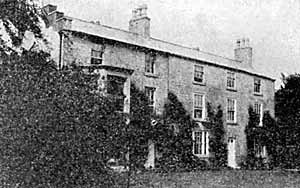 |
This is the mansion where the late Mr. E. Unwin, J.P., lived and died, his death taking place in 1841. A Mr. W. Bilson, many years a director, and partner, in the firm of the Unwins. also resided here. It is said that the cortege on the day of the first-named's funeral was the largest ever seen in Sutton, and deceased having been a large employer of labour, an enormous crowd made up of people from the surrounding villages gathered together in the churchyard to witness his burial in the family vault there.
The mansion, which is adjacent to the Old Mill, is now occupied by Mr. H. W. Cooke, the owner (as stated on page 24). It is very pleasantly situated, with its grassy lawn in the foreground and its improvised lake, centred with its ornamental fountain, in the background, and surrounded by well laid out gardens.
The small round building at the entrance to the Lawn from the Old Mill was built by the Unwin family for the purpose, it is believed, to keep the bleaching department at the works free from soot and smoke. A. shaft was constructed from the works to the building, in the hope that the smoke might be carried away by that channel, but whether it served the purpose intended we are not in a position to state. It is now styled "The Old Tower."
Writing in 1838, the late Dr. Spencer T. Hall states:—"About 70 years ago the first cotton mill in Sutton was erected by the Messrs. Unwin, near the site of the present extensive works. The machinery of this factory was originally propelled by oxen and horses, which, however, were soon superseded by a large water-wheel, when the concern was considerably extended. Fifty-three years since the factory took fire, and was much damaged. The works are now put in motion by steam, the supply of water being insufficient."
An incident might be mentioned here of three Suttonians (who in those days had not learnt to keep their hands from picking and stealing) robbing the Old Mill one evening of the large bell which invited the workpeople to their duties. They were promptly caught, however, and duly punished for the offence.
A number of rows of cottages, built of stone quarried from the estate near the Old Mill, by the Unwin family, are to be seen here and there in the parish. Most of the property has now, however, passed into other hands.
"THE NURSERY OF CRICKET."
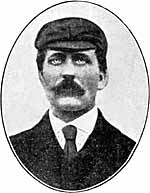 |
The late J C Shaw. |
Whether, or not, the town of Sutton became known throughout the length and breadth of the land on account of its musicians, authors, or astronomers, it is perfectly clear that a considerable share of its world-wide popularity has been earned by its famous professional cricketers! The first of the latter to bring about its renown was, doubtless, the late J. C. Shaw, while the lot to maintain it at the present time is in the hands of. we are proud to state, Tom Wass, the Notts. County right-arm fast bowler.
Shaw who was born at Sutton April 11th, 1887, made his debut in an important match in 1865, then being 28 years old. He afterwards played regularly for Notts. County and in All-England Eleven matches for 10 years, concluding his career in 1875. He proved to be one of the best medium-pace left-hand bowlers ever seen. For 16 of Notts, v. All-England on September 15th, 1870, he took all 10 wickets for 20 runs. He died March, 1888, in his 51st year, being buried in Sutton churchyard.
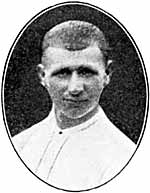 |
Tom Wass. |
Wass who was born at Sutton, December 28th, 1874, started his career with Notts. County v. M.C.C. and Ground in 1896, and is to-day one of the world's best right-hand fast bowlers. His successes have unfortunately, varied during the past 11 seasons owing to slight injuries received during some of the matches he was engaged in. We wish him every possible success in the future, and hope that he will continue to maintain Sutton's reputation in the same noble spirit as his predecessors have done. Sutton's other famous cricketers were:—The late W. Barnes, born at Sutton May 27th. 1852, died at Mansfield Woodhouse March, 1899 and is buried there The late Fred Morley, born at Sutton December 16th, 1850, died at Sutton (where he is buried) September 28, 1884. W. Flowers, born at Calverton, near Nottingham (coming to Sutton when an infant). Dec. 7th, 1856, now resides at Sherwood Rise. Nottingham, and is engaged by M.C.C as umpire. G. Bean, born at Sutton March 7th, 1864, now also engaged by M.C.C. as umpire. The late "Johnny" Briggs, born at Sutton October 3rd. 1862 died at Cheadle Jan. 11, 1902. and is buried near the Old Trafford.
The late J. Crossland, born at Sntton April 2nd. 1852. died at Blackburn September 29th, 1903, and is buried there. The late Tom Barnes (brother of W. Barnes), died in 1873, aged 24, and is buried at Sutton.
In their day, Messrs. T. and W. Barnes, Morley, Flowers, and Shaw represented Notts. County with conspicuous ability, Morley, Flowers, and W. Barnes also playing for M.C.C. and visiting Australia. Bean played for Sussex, and likewise visited Australia once with an English representative team. Crossland and Briggn represented Lancashire, the latter also journeying to Australia. Other players who have played for a short time with Notts. County were J. Lindley, C. Shore, and T. G. Buckland. At one time Sutton turned out about 70 professional Cricketers each Beason, and by the doughty deeds of the players mentioned the town gained the appellation of "The Nursery of Cricket."
SUTTON-IN-ASHFIELD CRICKET CLUB.
This Club acquired its present ground (the owners being the Unwin Family) in Hardwick Lane in 1904, at an outlay of upwards of £100. Towards that amount the Duke of Portland contributed £10, and is now an annual subscriber of £5. For many years previously the Club tenanted the New Cross Ground in Outram Street, which had to be relinquished owing to it passing into the builders' hands: The Club was temporarily disbanded on that account at the end of 1901 until the present ground was secured, and during that time the members joined other clubs in the town. Tom Wass formerly played with this Club, and is willing to assist it now when opportunity offers. The Secretary is Councillor H. S. Shacklock, Solicitor, Market Place, and President. Councillor G. Stevenson. The members number about 100. In 1905, the Club was the Champions of the Notts. League. The yearly rental of the ground is £15.
CRICKET MEMS.
Sutton Robin Hood, Sutton Cooke's, and Eastfield Side Baptist (formerly belonging to the Notts. League) became defunct two seasons ago.
There are several other clubs in existence in the parish.
A field known as "Hatchett Holmes," in Hucknall Road, is historic from the fact that Sutton and District opposed an English representative cricket team there in or about 1869. Other minor matches were also played there, including the well-known "Clown" Cricketers., This field, which was handed over to the builder by Mr. W. Hepworth in 1899, was also formerly used for other al fresco gatherings.
An extraordinary, bowling feat was accomplished on the Outram Street ground by F. Renshaw, of Sutton, on Saturday. June 30th. 1885, who was engaged as professional at Spalding. He was on a visit to Sutton, and playing with the Midland Hosiery Club against Bulwell he secured all 10 wickets for one run. Of these he clean bowled eight batsmen, four with successive balls. His analysis was—21 balls, 3 maidens, 1 run, 10 wickets.
Sutton now claims England's oldest umpire in Mr. Frank H. Farrands, of the Staff of Life Inn, who is 75 years. He first went to Lord's in 1868, and has regularly attended there for the past 40 years.
RIFLE CLUB.
This organisation was established April 5th, 1906. Dr. Mitchell is President, and Mr. B. Walton Secretary. The first competition was promoted on Jury 18th, 1906, on the Club's Range in Caudwell Road.
CHARTISM.
The years 1837-1848, when the Chartist movement was prevalent, are still green in the memories of our oldest inhabitants, who. undoubtedly, in those days had a very anxious time, through the many exciting, and more or less tumultuous, incidents that were created in the town and district. It will be remembered that the programme then drawn up by the late Daniel O'Connell was called "The People's Charter," and that one of the prominent leaders of the movement (the late Feargus O'Connor) paid a visit to Sutton and delivered an address in reference to the movement to a large crowd from the steps of the old engine-house which then stood on Portland Square. Fifty parishioners were "sworn in" as special constables before the late Mr. E. Unwin, J.P., to assist in maintaining "law and order" in cases of emergency, and residents were summoned for the most trivial offences. Those cases were chiefly dealt with at Mansfield, resulting in fines being imposed upon the defendants, whilst, it is said, that many were summarily disposed of by Mr. Unwin himself on the premises of the Old Mill. The magistrate used strenuous exertions to bring the chartists into submission, but he permitted his teal to overstep the bounds of his discretion when he entered and searched the dwelling-house of the late Mr. Joseph Bryan, one of the local leaders, residing then at the entrance to Union Street from Crown Street, without having previously obtained the necessary Search Warrant. Certain documents (purely of a business nature), as well as some silk stockings, it is stated, were seized, by which means the Justice of the Peace and his compeers felt convinced they would be able to bring about a conviction at the Notts. Assizes (1840), but, unfortunately for Mr. Unwin, the tables were turned, for instead of Mr. Bryan being convicted, a farthing damages were awarded the latter against Mr. Unwin for unlawfully entering his dwelling under the circumstances described. This decision of the Jury so enraged him that, it is said, he forthwith filed his petition in bankruptcy for debts amounting to a total of £30,000 to evade the order of the law. The trial occupied two or three days, the inhabitants supplying the funds to defray Mr. Bryan's costs of the case. Mr. Unwin, who went about the parish on horseback, accompanied by a special constable, grew so out of favour with the populace that, it is stated, one or two abortive attempts were made to remove him from their midst.
During those troublesome years, some 100 Cavalry were quartered at a farmstead near Caudwell Wood, and a troop was frequently to be seen in and around Sutton's thoroughfares, but no serious disturbance ever occurred to need their interposition. Many of the inhabitants lived in a state of terror, and anyone suspected of carrying arms underwent an examination by the soldiers!
It is believed that "Porter's Buildings" at Eastfield Side were in course of erection at that period. They are known now by that name, but formerly they were called "The Barracks,"—a designation which was applied on account of the Cavalry being stationed only a short distance away—but whether any were ever actually billeted in that particular vicinity we have been unable to glean facts to warrant an affirmative statement.
With the chartist movement, the days of the Unwin family in Sutton were practically ended. Mr. E. Unwin growing into disfavour, as before mentioned, and his death taking place in 1841, the family resolved to finally close the doors of the Old Mill Works, and, as far as its industries were concerned, leave Sutton for ever! All the machinery was gradually disposed of, and, sad to relate, this chartist episode forms one of the darkest pages in the annals of the town so far as industrially concerned!
< Previous | Contents | Next >
